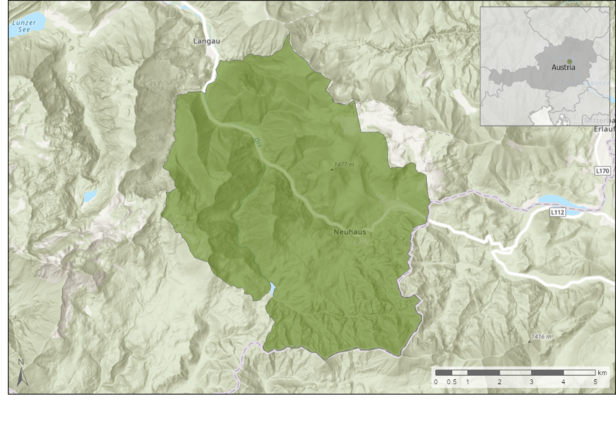
C22 Langau ¶
Close-to-nature management, reflections based on 20 years of experience ¶

General information on the Langau forest.
| Total forest area | 8431 ha |
| Organisational structure | four forest districts managed by four foresters; one head forest manager |
| Main management types | No clearcutting since 1994; selective felling at varying intensities |
| Total standing volume | 2 600 000 m³ |
| Annual growth | 5 m³/ha |
| Annual cut | 42 000 m³ |
| Deadwood (standing and lying) | 50 m³/ha (estimated) |
| Altitude | 1050 m a.s.l. |
| Ownership | Rothschild’sche Forstverwaltung Langau (owners of the trust were the members of the Rothschild family); since 2018/2019 the forest is owned by Prinzhorn Holding |
| Climate | Typical climate of the alpine foothills with high precipitation; seasonal extremes in late winter falling mainly as snow; often rainy periods in June/July; low annual average temperature (~5.7 °C) |
| Soil | Shallow dolomite rendzina soils; limestone brown loam; gravel in floodplain areas |
| Geology | Northeastern limestone Alps: limestone, dolomite with occasional occurrence of sandstone |
| Protected areas | 1159 ha of wilderness area (‘Wildnisgebiet Dürrenstein’); 216 ha of strict forest reserves (‘Hinterer Oiswald’) 11 ha of old-growth islands/patches |
| Natural forest community | Submontane and montane Norway spruce–fir–beech forests (Picea abies–Abies alba–Fagus sylvatica) with sycamore (Acer pseudoplatanus), ash (Fraxinus excelsior), mountain elm (Ulmus glabra); subalpine Norway spruce forest, beech forests, floodplain forests, ravine forests with sycamore and mountain elm |
